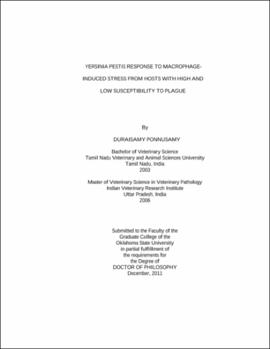| dc.contributor.advisor | Clinkenbeard, Kenneth D. | |
| dc.contributor.author | Ponnusamy, Duraisamy | |
| dc.date.accessioned | 2013-11-26T08:35:16Z | |
| dc.date.available | 2013-11-26T08:35:16Z | |
| dc.date.issued | 2011-12 | |
| dc.identifier.uri | https://hdl.handle.net/11244/7670 | |
| dc.description.abstract | Yersinia pestis causes severe disease in natural rodent hosts but mild to inapparent disease in rodent predators such as dogs. Y. pestis initiates infection in susceptible hosts by parasitizing and multiplying intracellularly in local macrophages during the early stage of infection. Thus, we hypothesized that Y. pestis infection severity may depend on how well the intracellular bacterium overcomes the initial host macrophage associated stress. To test this hypothesis, Y. pestis infection progress was studied in mouse splenic and dog peripheral blood macrophages, and various parameters of this infection were measured in mouse and dog tissue culture macrophages RAW264.7 and DH82, respectively. The study showed that during the early stage of infection, intracellular Y. pestis assumed filamentous cellular morphology with multiple genomes per bacterium in both mouse and dog macrophages. Later, in mouse macrophages, these filamentous Y. pestis returned to coccobacilli with spacious vacuolar extension of Yersinia containing vacuoles (YCV) and extensive macrophage lysis. However, in dog macrophages, intracellular Y. pestis were either retained in the same filamentous cellular morphology for the entire experiment in tissue culture cells or killed eventually in blood macrophages. In addition, Y. pestis infected dog macrophages did not show noticeable extension of YCV and macrophage lysis. To further understand the Y. pestis virulence factors in macrophage parasitism, protein profiles of Y. pestis residing in RAW264.7 cells were compared with those of culture grown Y. pestis. The experiment showed the expression of various general stress response and tellurite resistance proteins of Y. pestis. Tellurite resistance genes were analyzed for their possible role in Y. pestis intracellular stress regulation. This analysis indicated that Y. pestis tellurite resistance (ter) operon expression was induced as a response to the macrophage stress and expression of these proteins associated with conversion to a filamentous cellular morphology by Y. pestis similar to that observed in macrophage infections. These studies indicate that Y. pestis in mouse macrophages can overcome the initial intracellular stress and cause systemic infection. But failure to overcome the dog macrophage induced stress by Y. pestis may result in mild disease in these animals. During this intracellular parasitism, Y. pestis employs various general stress regulatory mechanisms to survive in macrophages. As a part of this stress response, expression of Y. pestis ter operon likely causes filamentous cellular morphology response in order to adapt to the macrophage associated stress. | |
| dc.format | application/pdf | |
| dc.language | en_US | |
| dc.rights | Copyright is held by the author who has granted the Oklahoma State University Library the non-exclusive right to share this material in its institutional repository. Contact Digital Library Services at lib-dls@okstate.edu or 405-744-9161 for the permission policy on the use, reproduction or distribution of this material. | |
| dc.title | Yersinia pestis response to macrophage-induced stress from hosts with high and low susceptibility to plague | |
| dc.contributor.committeeMember | Little, Susan E. | |
| dc.contributor.committeeMember | Snider, Timothy A. | |
| dc.contributor.committeeMember | Ayalew, Sahlu | |
| dc.contributor.committeeMember | Shaw, Edward I. | |
| osu.filename | Ponnusamy_okstate_0664D_11773 | |
| osu.accesstype | Open Access | |
| dc.type.genre | Dissertation | |
| dc.type.material | Text | |
| dc.subject.keywords | filamentous morphology | |
| dc.subject.keywords | intracellular stress response | |
| dc.subject.keywords | macrophage | |
| dc.subject.keywords | tellurite resistance proteins | |
| dc.subject.keywords | Yersinia pestis | |
| thesis.degree.discipline | Veterinary Pathobiology | |
| thesis.degree.grantor | Oklahoma State University | |
